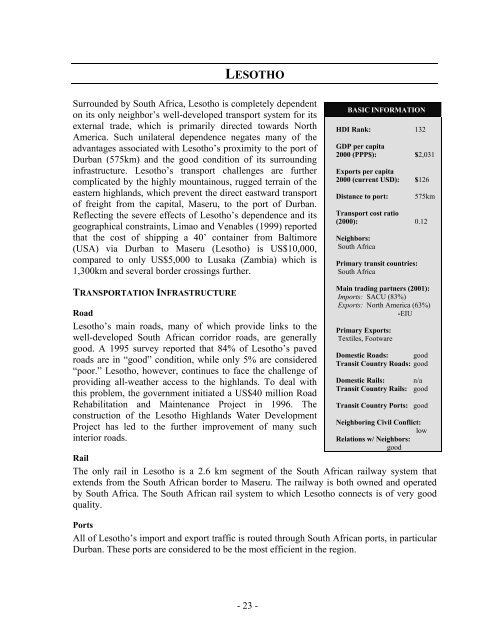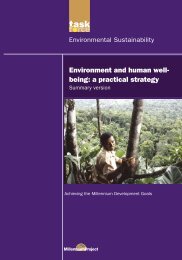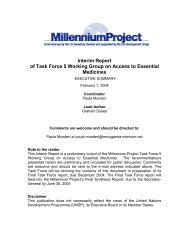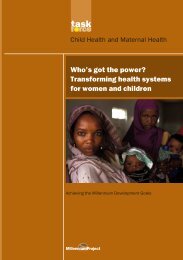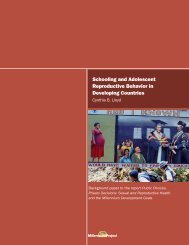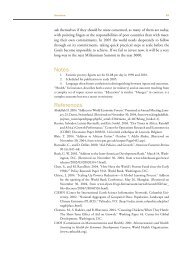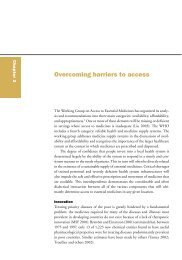the challenges facing landlocked developing countries: a case study ...
the challenges facing landlocked developing countries: a case study ...
the challenges facing landlocked developing countries: a case study ...
You also want an ePaper? Increase the reach of your titles
YUMPU automatically turns print PDFs into web optimized ePapers that Google loves.
LESOTHO<br />
Surrounded by South Africa, Lesotho is completely dependent<br />
on its only neighbor’s well-developed transport system for its<br />
external trade, which is primarily directed towards North<br />
America. Such unilateral dependence negates many of <strong>the</strong><br />
advantages associated with Lesotho’s proximity to <strong>the</strong> port of<br />
Durban (575km) and <strong>the</strong> good condition of its surrounding<br />
infrastructure. Lesotho’s transport <strong>challenges</strong> are fur<strong>the</strong>r<br />
complicated by <strong>the</strong> highly mountainous, rugged terrain of <strong>the</strong><br />
eastern highlands, which prevent <strong>the</strong> direct eastward transport<br />
of freight from <strong>the</strong> capital, Maseru, to <strong>the</strong> port of Durban.<br />
Reflecting <strong>the</strong> severe effects of Lesotho’s dependence and its<br />
geographical constraints, Limao and Venables (1999) reported<br />
that <strong>the</strong> cost of shipping a 40’ container from Baltimore<br />
(USA) via Durban to Maseru (Lesotho) is US$10,000,<br />
compared to only US$5,000 to Lusaka (Zambia) which is<br />
1,300km and several border crossings fur<strong>the</strong>r.<br />
BASIC INFORMATION<br />
HDI Rank: 132<br />
GDP per capita<br />
2000 (PPP$): $2,031<br />
Exports per capita<br />
2000 (current USD): $126<br />
Distance to port:<br />
575km<br />
Transport cost ratio<br />
(2000): 0.12<br />
Neighbors:<br />
South Africa<br />
Primary transit <strong>countries</strong>:<br />
South Africa<br />
TRANSPORTATION INFRASTRUCTURE<br />
Road<br />
Lesotho’s main roads, many of which provide links to <strong>the</strong><br />
well-developed South African corridor roads, are generally<br />
good. A 1995 survey reported that 84% of Lesotho’s paved<br />
roads are in “good” condition, while only 5% are considered<br />
“poor.” Lesotho, however, continues to face <strong>the</strong> challenge of<br />
providing all-wea<strong>the</strong>r access to <strong>the</strong> highlands. To deal with<br />
this problem, <strong>the</strong> government initiated a US$40 million Road<br />
Rehabilitation and Maintenance Project in 1996. The<br />
construction of <strong>the</strong> Lesotho Highlands Water Development<br />
Project has led to <strong>the</strong> fur<strong>the</strong>r improvement of many such<br />
interior roads.<br />
Main trading partners (2001):<br />
Imports: SACU (83%)<br />
Exports: North America (63%)<br />
-EIU<br />
Primary Exports:<br />
Textiles, Footware<br />
Domestic Roads: good<br />
Transit Country Roads: good<br />
Domestic Rails: n/a<br />
Transit Country Rails: good<br />
Transit Country Ports: good<br />
Neighboring Civil Conflict:<br />
low<br />
Relations w/ Neighbors:<br />
good<br />
Rail<br />
The only rail in Lesotho is a 2.6 km segment of <strong>the</strong> South African railway system that<br />
extends from <strong>the</strong> South African border to Maseru. The railway is both owned and operated<br />
by South Africa. The South African rail system to which Lesotho connects is of very good<br />
quality.<br />
Ports<br />
All of Lesotho’s import and export traffic is routed through South African ports, in particular<br />
Durban. These ports are considered to be <strong>the</strong> most efficient in <strong>the</strong> region.<br />
- 23 -


